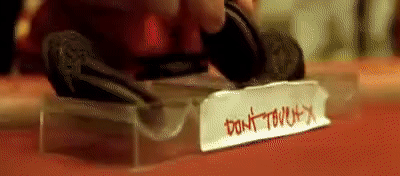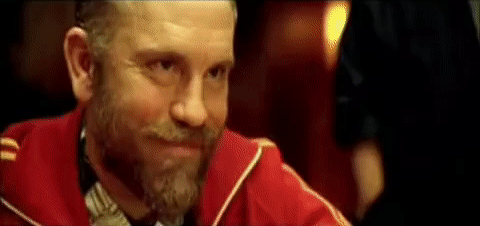Why Teddy KGB is Actually Bad at Poker
Teddy KGB is a feared character in Rounders, the most iconic poker movie of all time.
Teddy’s scary traits include his status as a Russian mob boss and deep ties into the New York City underworld.
Those traits do not necessarily include his skill at the poker table, which (spoiler alert) lead to Mike McDermott taking Teddy to school by the end of the movie.
The movie tries to portray Teddy as a master at the tables, but he doesn’t seem so skillful based on the hands we see, even by 1998’s lower standard of strategy.
With all we know in 2020, let’s go over the evidence — three reasons why Teddy KGB is bad at poker:
1. Teddy KGB is Bad at Sizing His Bets
Using the size of the current pot to inform your bets is one of the most fundamental parts of poker strategy, but Teddy KGB does not seem to do that.
Teddy rarely seems to bet less than the size of the pot in the entire movie. Top-tier poker players do mix in overbets on occasion, but Teddy seems to fire massive wagers into the pot in every hand he plays.
The first hand of the movie is a good example of this. You may remember it as the hand in which Mike McDermott plays over his head and loses his entire bankroll to Teddy.
Watch Doug Polk’s analysis of the hand below, or keep scrolling for the written analysis.
Blinds: $50/$100. Effective Stack Size: $60,000.
Mike opens to $600 on the button with A♣ 9♣. Teddy KGB calls in the big blind with A♥ A♦.
(We’ll revisit this hand and address Teddy’s preflop call with pocket aces later.)
The pot is $1,250, and the flop comes:
Teddy checks, Mike overbets for $2,000, and Teddy calls.
(Note: this overbet from Mike doesn’t make much sense, but let’s stay focused on Teddy.)
With the pot now at $5,250, the turn is the:
Both players check.
The pot is still $5,250 and the river comes:
Teddy overbets three times the pot, wagering $15,000 into the $5,250 pot.
A smaller bet size is most certainly a better option in Teddy’s spot. Mike is playing deep stacked and still has $48,000 behind (480 big blinds). Versus such a huge bet, Mike could be hesitant to raise with trip nines or a flush.
In fact, Mike may even be able to find a fold with trip nines because, against such a large bet, he can only beat the bluffs from Teddy’s range of hands.
If Teddy goes for a smaller bet — somewhere between $5,000 and $10,000 — Mike will at least call if he has trips or a flush. A smaller bet size will also make it more likely Mike raises with a hand like a flush or even a bluff, which would obviously be a welcome sight for Teddy.
Since he happens to have the second best possible full house, Mike raises all in for $48,000 and Teddy rakes in the huge pot. But suppose Mike was holding anything other than a full house. In those (much more likely) cases, Teddy’s overbet will be met by a call from Mike, at best, and a fold at worst.
Side note: Mike would probably also play pocket nines (now four-of-a-kind) this same way. That means Teddy actually loses to a significant portion of Mike’s very tight shoving range on the river. Makes you wonder how the movie would play out differently if Mike was holding 9♦ 9♣.
Teddy keeps up the ridiculously big wagering in his other hands against Mike. We’ll see some examples of that in the hands that follow.
Note: Ready to join 5,000+ players currently upgrading their No Limit Hold’em skills? Crush your competition with the expert strategies you will learn inside the Upswing Lab training course. Learn more now!
2. Teddy KGB’s Preflop Hand Selection is Bad
In the previous hand, we saw Teddy KGB just call from the big blind with pocket aces against Mike’s open on the button. With incredibly deep stacks, Teddy is practically throwing money away by not re-raising preflop.
When you’re in the big blind facing a raise from the player on the button, you should 3-bet with pocket aces 100% of the time (unless you’re short stacked). Simply put, Teddy should be looking to build the preflop pot with his premium pocket pair.
Additionally, just calling versus Mike’s button raise is asking for troublesome scenarios after the flop. Just about any flop could improve Mike’s hand to two pair or better, especially if Mike is playing a loose opening range from the button. By 3-betting, Teddy forces Mike to continue with a more defined range, which will make the hand easier to play.
But Teddy’s poor preflop hand selection doesn’t end there…
The following hand occurs toward the end of the movie during Mike and Teddy’s heads-up, winner-take-all match.
Blinds: $50/$100
The exact preflop action and stack sizes are unknown. However, we can see in the scene that there’s $500 in front of Teddy (pictured below in the blue box).
Teddy KGB, mid-tell, about to fire a massive overbet with the nuts.
(These fellas are playing the old school version of heads up poker where the player not on the dealer button acts first. The dealer acts first in modern heads up games.)
Based on the $500 in front of Teddy, we can safely assume that one of two things happened preflop:
- Mike raised to $500 and Teddy called.
- Mike called the size of the big blind, Teddy raised to $500, and Mike called.
Either way, there’s $1,000 in the pot and the flop comes:
Mike checks and Teddy slides two stacks of black chips (worth $4,000) into the pot. Another absurd overbet.
Mike, sensing that he’s in trouble, thinks it over for awhile before folding top two pair (A♥ 5♦) face up. The fold enrages Teddy, who thinks Mike should have paid him off.

We don’t get to see Teddy’s hand, but Mike calls him out for having 4-2 for a wheel straight. Teddy’s reaction confirms this.
Depending on whether or not his cards were suited, Teddy’s preflop hand selection here is either somewhat bad or comically terrible. Putting $500 into the pot preflop with 4-2 suited is ambitious at best, even with position. Putting $500 into the pot with 4-2 offsuit is a downright awful play.
We’ve covered some of the very questionable plays Teddy KGB makes throughout the movie, but his greatest weakness has nothing to do with his strategy…
3. Teddy is Bad at Hiding His Tells
Teddy’s penchant for spectacularly obvious tells proves to be his undoing in Rounders. By the end of the movie, Mike’s keen sense of live reads has allowed him to crush Teddy in his own underground poker game.
Going back to the first hand we discussed, when Mike bet $2,000 into a $1,250 pot on a A♠ 9♠ 8♣ flop…
Teddy picks up one of his trademark Oreo cookies, puts it to his ear, splits it in two, then eats it before making the call. As we know, Teddy did this while holding the best possible hand, A♥ A♦.
During the final heads-up match, Mike open-raises huge (20 big blinds) with pocket kings, Teddy 3-bets to half of his stack (100 big blinds — yet another huge overbet), and Mike 4-bets all-in.
Facing the all-in, Teddy once again picks up an Oreo, but this time he doesn’t eat it. He puts it back in the tray and folds, indicating he did not have the hand he was representing (aces).
This brings us back to the hand where Mike makes the big fold with A♥ 5♦ on A♣ 5♠ 3♦. Mike is about to bet this flop with his top two pair when Teddy goes for the Oreo-to-the-ear move again, slowly separating the cookie and savoring the treat.

Mike realizes that Teddy did this exact same move when he held the nuts on the earlier A♠ 9♠ 8♣ flop. So, Mike decides to check. Teddy puts out one of his usual overbets and Mike makes the big laydown.
After Mike calls Teddy out for having the nuts, Teddy, in disbelief, throws his chip rack full of cookies against the wall, presumably realizing his Oreo tell as a fatal flaw.
Final Thoughts
Teddy, in general, gives off too much information at the table. A sharp rounder like Mike McDermott can pick up on that information and tear Teddy to shreds, as he does by the end of the movie.

Teddy is also prone to tilt, and makes minus-EV moves.
In fact, just playing the heads-up match against Mike is arguably a minus-EV move.
Mike has shown up with $10,000 of the $15,000 debt he owes Teddy, and Teddy is giving up that $10,000 to risk a scenario where he actually ends up losing money to Mike.
What was Teddy’s upside? Was Mike going to become his poker slave if he won?
If you want more analysis of fictional poker hands, check out Rounders Analyzed: 3 Hands Played By Mike McDermott & Teddy KGB.
Note: Learn step-by-step how to become the best player at the table when you join the Upswing Lab training course. Elite pros have been adding new content every week for the past four years, and you get all of it when you join. Learn more now!